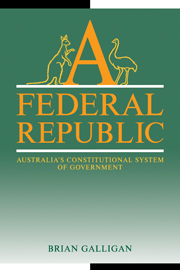Book contents
- Frontmatter
- Contents
- Tables and figures
- Preface
- Dedication
- Introduction
- 1 A federal republic
- 2 Federal theory and Australian federalism
- 3 The Senate and responsible government
- 4 Labor and the Australian Constitution
- 5 The referendum process
- 6 The protection of rights
- 7 The High Court and the Constitution
- 8 Intergovernmental relations and new federalism
- 9 Fiscal federalism
- 10 Towards and beyond 2001
- Bibliography
- Index
8 - Intergovernmental relations and new federalism
Published online by Cambridge University Press: 05 November 2011
- Frontmatter
- Contents
- Tables and figures
- Preface
- Dedication
- Introduction
- 1 A federal republic
- 2 Federal theory and Australian federalism
- 3 The Senate and responsible government
- 4 Labor and the Australian Constitution
- 5 The referendum process
- 6 The protection of rights
- 7 The High Court and the Constitution
- 8 Intergovernmental relations and new federalism
- 9 Fiscal federalism
- 10 Towards and beyond 2001
- Bibliography
- Index
Summary
Through the Constitution the Australian people established a system of multiple governments organised on a federal basis. Such a system inevitably entails complex and elaborate relations among governments in public policy-making and implementation. While intergovernmental relations are subconstitutional they are informed and structured by the Constitution. Moreover, there is enormous scope for improving the working of the federal system through reforming intergovernmental arrangements. It is here, rather than on constitutional reform, that attention needs to be focused because the outstanding issues requiring improvement in the Australian federal system can be remedied without constitutional change by restructuring intergovernmental arrangements.
One notable area for reform is redressing the acute imbalance between taxing and spending responsibilities of the Commonwealth and the States, called vertical fiscal imbalance, which will be considered in chapter 9. This chapter examines the Australian system of intergovernmental relations and recent attempts at improving their operation in shared policy areas.
Despite their significance for Australian politics and public policy, intergovernmental relations have been relatively neglected by those studying Australian federalism. Constitutional lawyers and fiscal economists, with little interest or competence in intergovernmental relations, restricted their focus to the more formal aspects of federalism. Political scientists, for the most part, did not remedy their oversight in the postwar decades because of a fixation with national politics and policy-making.
A towering exception was Rufus Davis who, after completing his PhD on federal-state relations at the London School of Economics and Political Science in 1950, published several articles on the subject (1952, 1955–56).
- Type
- Chapter
- Information
- A Federal RepublicAustralia's Constitutional System of Government, pp. 189 - 213Publisher: Cambridge University PressPrint publication year: 1995
- 1
- Cited by



